This guide will help you navigate the legal, logistical and operational complexities of moving a retail store while keeping your customers happy and your business running. We also include helpful checklists for relocating your retail store at every step.
1. Plan Ahead
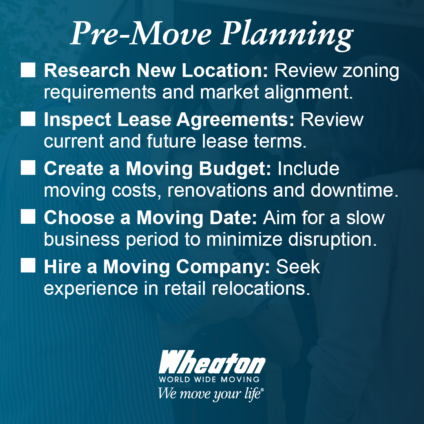
It’s never too early to start planning, especially when orchestrating a complete retail store relocation. Once you decide to move, it’s time to do your homework.
Finding the perfect location is more than falling in love with a space. It involves carefully reviewing the lease agreement and local regulations. If you’re relocating your store to a new city or new state, there may be different laws that affect how you conduct business. Make sure you consider:
- Zoning and Permits: Ensure your new location is zoned for retail operations. Some areas may have specific permits or restrictions for signage, parking or business hours.
- Lease Agreements: Review the lease terms of both your current and future locations. Look for early termination fees or clauses about subleasing your current space.
- Employee and Labor Laws: If you’re relocating to a different state or city, familiarize yourself with local labor laws. These might affect wage rates, overtime policies or workers’ compensation requirements.
- Moving Budget: Carefully consider all the expenses you’ll have with your move, including the moving company, any renovations you’ll need to make in your new space and any lost revenue during the transition.
- Moving Company: Vet several moving companies and get estimates from each. Be wary of especially low estimates; they may indicate rogue movers.
2. Do Your Paperwork
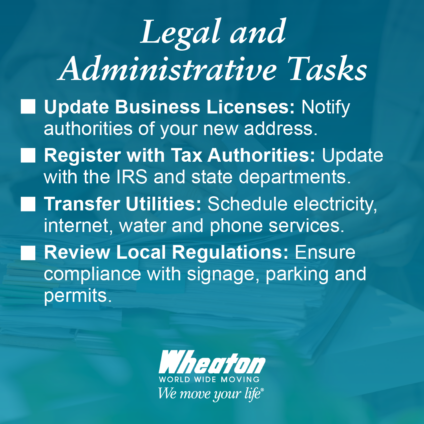
Before you move, consult with your attorney to determine which steps you must take in order to legally open and conduct your retail operation in a new location. Make sure you address all business-related issues at both your old and new locations.
- Business Licenses and Taxes: Update your business license to reflect the new address. Notify the IRS, state tax authorities and local tax offices to avoid penalties.
- Utility Transfers: Schedule transfers or installations of electricity, water and internet well in advance.
- Comply with Local Regulations: Ensure you and your employees understand and comply with signage, parking and permits. Research how to obtain the permits and licenses you need in the new location before you sign a property lease or sales agreement.
3. Announce Your Move (Without Losing Customers)
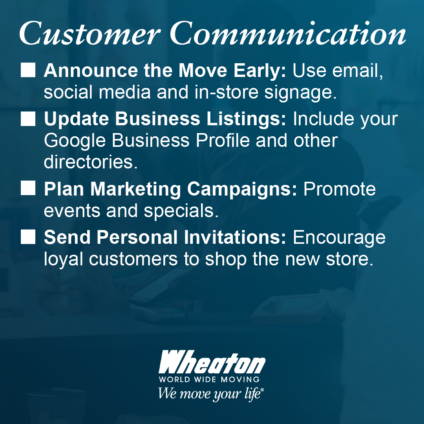
Once you’ve chosen the new spot for your retail business, it’s time to spread the word. Clear communication is essential to ensure customers follow you to your new location. Here are some strategies:
- Use Multiple Channels: Announce your move on your website, social media, email newsletters and in-store signage.
- Special Offers: Incentivize customers to visit your new store with a grand reopening sale or loyalty rewards for visiting both old and new locations.
- Press Releases: Send out press releases to local newspapers or blogs to generate buzz about your move.
- Updated Listings: Immediately after the move, update your address on your Google Business Profile, Yelp, and other directories.
- Personal Touch: Create personalized messages for loyal customers to thank them for their support and invite them to your new space.
Update your address and other contact details before you hang your open sign on the door after your retail shop relocation to ensure that you’ll appear on the map.
4. Keep Your Business Running Through the Transition
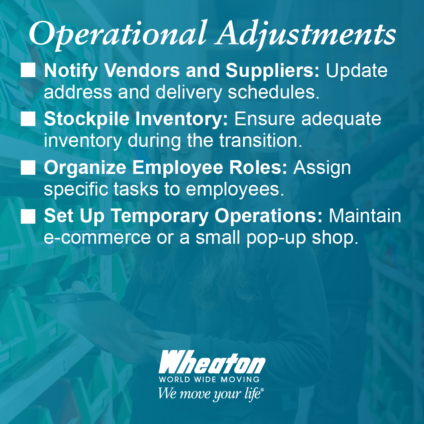
As you prepare for your transition, minimize downtime. Here a ways to reduce the impact of your move on daily operations:
- Stockpile Inventory: Ensure you have enough inventory on hand to fulfill orders before, during and immediately after the move.
- Temporary Operations: Set up a temporary space or continue e-commerce operations while the physical move is underway.
- Staggered Moving: To keep your store operational for as long as possible, move in phases, starting with non-essential items first.
- Employee Planning: Assign specific roles to employees during the move to complete tasks efficiently.
- Communication with Vendors: Inform suppliers and partners of your move to avoid disruptions in deliveries.
5. Plan the Logistics of Moving Your Business
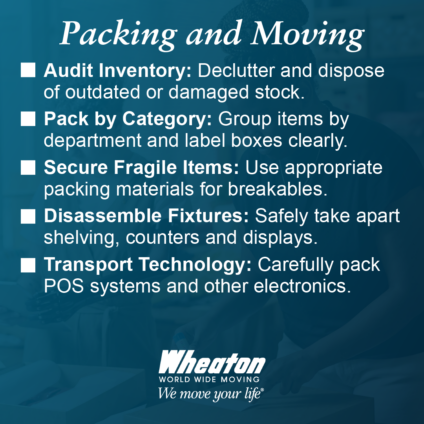
Efficient logistics are the backbone of a successful move. Approach packing and moving with a clear plan:
- Create a Timeline: Map out every stage of the move, from packing to reopening, with realistic deadlines.
- Inventory Management: Conduct a thorough inventory check before and after the move to prevent loss or misplacement.
- Label Everything: Clearly label boxes with their contents and the department they belong to in the new store.
- Special Equipment: Plan for the safe transport of sensitive equipment like POS systems, refrigerators, or unique displays.
- Contingency Plans: Build buffer days into your schedule for unexpected delays.
6. Make Your New Store Appeal to New and Old Customers
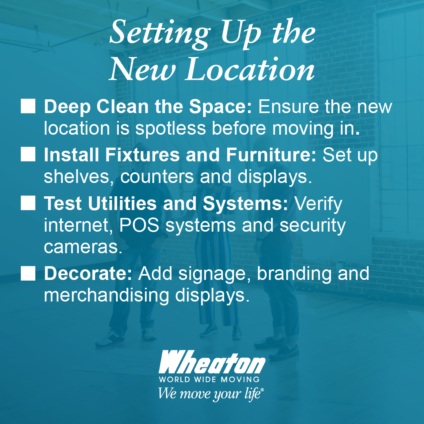
A new location is an opportunity to refresh your brand. Here are ways to leverage your fresh start without alienating loyal customers:
- Store Design: Invest in modern, customer-friendly layouts that enhance shopping experiences.
- Local Touch: Incorporate elements of the local culture to make your store feel connected to the community.
- Exclusive Launch Products: Offer exclusive products or services to attract customers to your new store.
- Feedback Opportunities: Use surveys or comment boxes to learn what your old customers love and what new customers want.
- Loyalty Programs: Offer transfer deals or enhanced benefits for existing members of your loyalty program.
7. Create an Experience for Shoppers
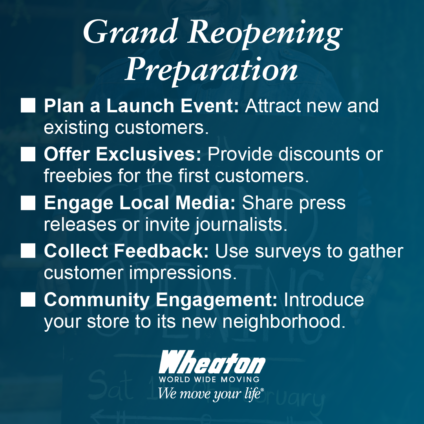
Shoppers today respond to experiential marketing. Follow these tips to immerse them in brand image and presence:
- Gala Opening: Make your launch an event that new and old customers won’t want to miss.
- Exclusive Offers: Offer freebies, special deals and exclusive items to stir interest and encourage business.
- Local Hype: Engage local media to spotlight your shop and spread the word about your opening.
- Invite the Neighbors: Get to know the other businesses in the area by inviting them to visit your shop. Build a sense of community commitment early on.
8. Evaluate How it Went
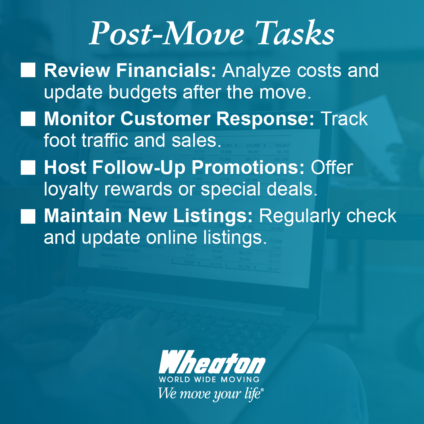
After the dust has settled and the receipts have been counted, take the time to evaluate how your store location went:
- Do the Numbers: Did the cost of your move match your estimate? Were you able to offset expenses through grand opening promotions?
- Get Feedback: Talk to customers. Find out what they like or don’t like about your new store, and solicit suggestions for improvement.
- Keep Momentum: Plan and host future events to make your shop a local destination. Create loyalty programs for returning customers.
- Online Presence: Use social media, email and other forms of digital communication to maintain connection with your customer base.
How a Moving Company Can Help
A professional moving company can take the heavy weight off your shoulders so that you can focus on your business plan:
- Packing Services: Movers can efficiently pack your store’s items and make sure they remain secure and organized during the move.
- Specialized Transport: Professional movers have the equipment and expertise to handle heavy furniture, fragile displays and specialized equipment.
- Project Management: Moving companies like Wheaton offer an agent or project manager to coordinate every aspect of the move.
- Insurance and Accountability: Hiring a reputable moving company ensures your items are insured in case of mishap.
- Storage Solutions: Moving companies often provide temporary storage options if your new location isn’t ready.
Get In Touch with the Commercial Move Experts
Wheaton World Wide Moving offers specialized and commercial moving services for retail customers. Let us bear the logistical burdens during your retail shop relocation. Contact us today to learn more.



